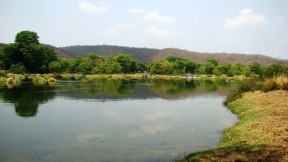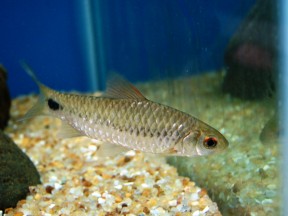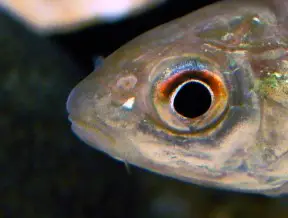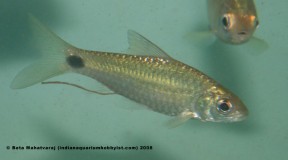Puntius mahecola
SynonymsTop ↑
Leuciscus mahecola Valenciennes, 1844
Etymology
mahecola: apparently named for the type locality, Mahé, an enclave forming part of the Union Territory of Puducherry located within the state of Kerala, southwestern India.
Classification
Order: Cypriniformes Family: Cyprinidae
Distribution
Described from ‘Mahé, Kerala, India’, but currently considered to occur in rivers draining much of the Western Ghats mountains in Kerala, Karnataka, and Tamil Nadu states.
In Kerala records exist from the Meenachil River in Kottayam district , the Achankovil and Periyar Rivers in Pathanamthitta district, the Kallada River in Kollam District, and the Chalakudy River.
In Karnataka it’s been collected close to Chikmagalur and from the Kali River, while in Tamil Nadu it’s known from the Thamirabarani River system and waters around the city of Chennai.
Habitat
According to Pethiyagoda and Kottelat it inhabits shallow (less than 2 metre deep), slow-flowing sections of rivers over substrates of sand or mud, but flow rate and water volume are likely to vary depending on time of year and increase significantly during the annual monsoons.
It can also be found in some lagoons and artificial lakes formed by damming of rivers.
Other species found in the same general area include Pethia conchonius, Puntius denisonii, Dravidia fasciata, Dawkinsia arulius, D. filamentosa, D. rubrotinctus, Barilius bakeri, B. bendelisis, B. canarensis, Devario malabaricus, Esomus danricus, Garra mcclellandi, G. hughi, Bhavania australis, Travancoria jonesi, Mesonoemacheilus guentheri, M. triangularis, Schistura denisonii, Lepidocephalichthys thermalis, Batasio travancoria, Mystus armatus, M. canarensis, Glyptothorax annandalei, Aplocheilus lineatus, Parambassis thomassi, Etroplus canarensis, E. maculatus, Sicyopterus griseus, Pseudosphromenus dayi, Channa striata, and Carinotetraodon travancoricus.
Maximum Standard Length
70 – 75 mm.
Aquarium SizeTop ↑
Base dimensions of at least 90 ∗ 30 cm or equivalent are required.
Maintenance
Fairly easy to maintain provided a dedicated maintenance routine is adhered to, with choice of décor is more-or-less down to personal taste.
A natural-style arrangement could include a substrate of sand or gravel with plenty of larger, water-worn rocks and pebbles plus some driftwood or twisted roots and branches.
Lighting can be relatively subdued and plants able to grow in such conditions from genera such as Microsorum, Taxiphyllum, or Anubias spp. added if you wish.
Although turbulent conditions aren’t required this species fares best when the water is well-oxygenated with a degree of flow meaning use of an over-sized external filter or two is recommended, and in terms of maintenance weekly water changes of 30-50% tank volume should be considered routine.
Water Conditions
Temperature: 18 – 24 °C
pH: 6.0 – 7.5
Hardness: 90 – 268 ppm
Diet
Likely to be a foraging omnivore feeding on worms, insects and other small invertebrates, as well as plant material and organic detritus.
In the aquarium it’s easily-fed but the best condition and colours offer regular meals of small live and frozen foods such as bloodworm, Daphnia and Artemia, alongside good quality dried flakes and granules, at least some of which should include additional plant or algal content.
Behaviour and CompatibilityTop ↑
This species is generally peaceful and an ideal resident of the well-researched community aquarium.
As it places no special demands in terms of water chemistry it can be combined with many of the most popular fish in the hobby including other small cyprinids as well as tetras, livebearers, rainbowfishes, anabantoids, catfishes, and loaches.
It?s a schooling species by nature and ideally should be kept in a group of at least 8-10 specimens.
Maintaining it in decent numbers will not only make the fish less nervous but result in a more effective, natural-looking display, plus males will also display their best colours as they compete with one other for female attention.
Sexual Dimorphism
Adult males are likely to be slightly smaller, slimmer, and display more intense colour pattern than females.
Reproduction
Unrecorded.
NotesTop ↑
This species is uncommon in the international aquarium trade but quite popular among enthusiasts of native species in India.
It has a chaotic taxonomic history with certain issues still to be resolved. While the name P. mahecola was misapplied to members of the genus Dawkinsia for over a century the fish itself has been widely misidentified as the congener P. amphibius (Valenciennes, 1842).
Its identity was partially resolved by Pethiyagoda and Kottelat (2005b) who demonstrated that though valid P. mahecola is not a Dravidia pecies but rather a smaller, relatively plain species with a single dark blotch on the caudal peduncle, located entirely posterior to the anal-fin.
Several members of the genus Dawkinsia, particularly D. assimilis, continue to appear on aquarium trade lists as ‘mahecola barb’ or P. mahecola.
Following Pethiyagoda and Kottelkat (2005b) P. mahecola sensu stricto can be told apart from all other Puntius spp. occurring in southern India and Sri Lanka by the following combination of characters: last simple dorsal-fin ray smooth; body depth 27.2-32.0 % SL; a single pair of maxillary barbels, about ½ eye diameter in length; 22-23 +1-3 lateral line scales; ½4+1+3½ transverse scale rows; a horizontally-elongate black blotch about 1½ times as wide as it is high running across 3½ scales of lateral line immediately behind the anal-fin base.
The identities of Barbus melanostigma (Day, 1878) and P. amphibius were also discussed.
Like P. mahecola the former was described from Kerala (Wayanad district) and shares a colour pattern of plain body and dark caudal peduncle marking but according to Day’s figure may be a deeper-bodied fish.
Pethiyagoda and Kottelat (2005b) considered it conspecific with P. mahecola but only examined a single specimen and at present it is considered a junior subjective synonym of P. mahecola.
The type locality of P. amphibius is ‘Bombay’, i.e., modern-day Mumbai, some distance north of Kerala, but its identity has been unclear since Day (1878) applied the name to P. mahecola sensu stricto, an error which was followed by many subsequent authors.
The lectotype designated by Pethiyagoda and Kottelat differs from P. mahecola by its smaller eye diameter measuring 61.6 % of snout length (vs. 68.4-100 %) and absence of any marking on the caudal peduncle, therefore it’s currently considered to be an entirely plain-bodied fish.
The paralectotype of P. amphibius does display a faint caudal peduncle marking, however, although no mention of this was made in the original description.
Further, although ‘P. amphibius‘ has been considered widely-distributed throughout the Indian peninsula and Sri Lanka the authors were unable to match it to any known extant Puntius species and its identity thus remains questionable in the absence of freshly-collected material.
P. arenatus (Day 1878) was not discussed but was described as a plain-bodied fish from Madras, now Chennai, and may also be related to this group. P. madhusoodani Kumar, Benno Pereira & Radhakrishnan 2012 is also similar-looking but differs from P. mahecola in possession of 3 branched and 7 unbranched dorsal-fin rays (vs. 3 branched and 8½ unbranched), 9 (vs. 8) predorsal scales, larger eyes measuring 10.7 % SL (vs. 8.6 % SL), shorter predorsal length measuring 34.91 % SL (vs. 53.3 % SL) and ‘higher body width’ [sic] measuring 18.95 % SL (vs. 14.4 % SL).
Based on the above it’s therefore considered best to refer to any Puntius specimen from southwestern India with a plain body and dark caudal peduncle marking as P. mahecola pending further investigation of some of these fishes, particularly P. amphibius and P. melanostigma (R. Kumar, pers. comm.).
It should also be noted that the intensity of the caudal peduncle marking can vary with mood and condition of the fish, appearing almost invisible at times.
The genus Puntius was viewed as a polyphyletic catch-all containing over 100 species of small to mid-sized cyprinid for a number of years until Pethiyagoda et al. (2012) published a partial review covering South Asian members.
The majority of sub-Himalayan Puntius species were reclassified and new genera Dawkinsia, Dravidia, and Pethia erected to accomodate some of them, with the remainder either retained in Puntius or moved to the existing Systomus assemblage, though the definition of the latter was altered meaning some Southeast Asian species formerly placed there are no longer members.
It subsequently became clear that the name Dravidia was preoccupied by a genus of flesh fly, therefore the replacement name Haludaria was made available by Pethiyagoda (2013).
P. mahecola was retained in Puntius sensu stricto, of which members are defined by the following combination of characters: adult size usually less than 120 mm SL; maxillary barbels absent or present; rostral barbels absent; 3-4 unbranched and 8 branched dorsal-fin rays; 3 unbranched and 5 branched anal-fin rays; last unbranched dorsal-fin ray weak or strong and unserrated; lateral line complete with 22-28 pored body scales; free uroneural present; gill rakers simple and acuminate (not branched or laminate); no antrorse predorsal spinous ray; post-epiphysial fontanelle usually present (except in P. bimaculatus and P. titteya); 4 supraneurals; infraorbital 3 slender; 5th ceratobranchial narrow; pharyngeal teeth 5 + 3 + 2; 12-14 abdominal and 14-16 caudal vertebrae; colour pattern including a (sometimes faint) blackish spot on the caudal peduncle.
No species from Indochina, China, or Indonesia were included in the study meaning a significant number of former Puntius are currently classed as incertae sedis, i.e., of uncertain taxonomic placement, and this also applies to a number of South Asian species of unresolved status.
They’re perhaps best referred to as ‘Puntius‘ for the time being whereby the genus name is surrounded by quotation marks to denote its questionable usage, and that is the convention used here on SF at the moment.
References
- Cuvier, G. and A. Valenciennes, 1844 - Histoire naturelle des poissons v. 17: i-xxiii + 1-497
Histoire naturelle des poissons. Tome dix-septième. Suite du livre dix-huitième. Cyprinoïdes. - Cuvier, G. and A. Valenciennes, 1842 - Histoire naturelle des poissons v. 16: i-xx + 1-472
Histoire naturelle des poissons. Tome seizième. Livre dix-huitième. Les Cyprinoïdes. - Day. F., 1878 - The fishes of India Part 4: i-xx + 553-779
The fishes of India; being a natural history of the fishes known to inhabit the seas and fresh waters of India, Burma, and Ceylon. - Kottelat, M. and H-H Tan, 2011 - Ichthyological Exploration of Freshwaters 22(3): 209-214
Systomus xouthos, a new cyprinid fish from Borneo, and revalidation of Puntius pulcher (Teleostei: Cyprinidae). - Kumar, K. K., F. G. Benno Pereira, and K. V. Radhakrishnan, 2012 - Biosystematica 5(2): 31-37
Puntius madhusoodani (Teleostei: Cyprinidae), a new species of barb from Manimala River, Kerala, South India. - Pethiyagoda, R., 2013 - Zootaxa 3646(2): 199
Haludaria, a replacement generic name for Dravidia (Teleostei: Cyprinidae). - Pethiyagoda, R. and M. Kottelat, 2005b - Raffles Bulletin of Zoology Supplement 12: 145-152
The identity of the south Indian barb Puntius mahecola (Teleostei: Cyprinidae). - Pethiyagoda, R. and M. Kottelat, 2005a - Raffles Bulletin of Zoology Supplement 12: 127-144
A review of the barb of the Puntius filamentosus group (Teleostei: Cyprinidae) of southern India and Sri Lanka. - Pethiyagoda, R., M. Meegaskumbura, and K. Maduwage, 2012 - Ichthyological Exploration of Freshwaters 23(1): 69-95
A synopsis of the South Asian fishes referred to Puntius (Pisces: Cyprinidae).












